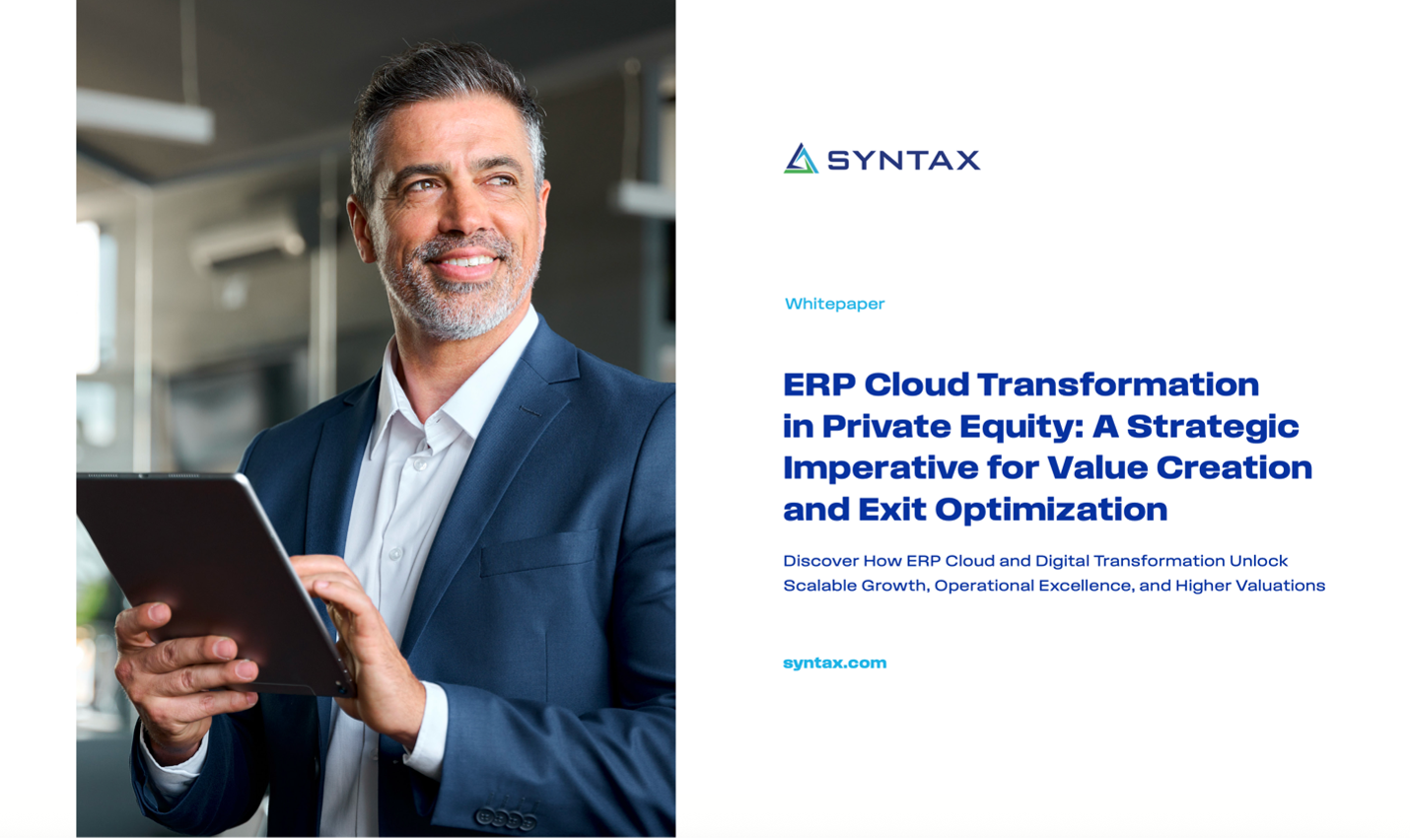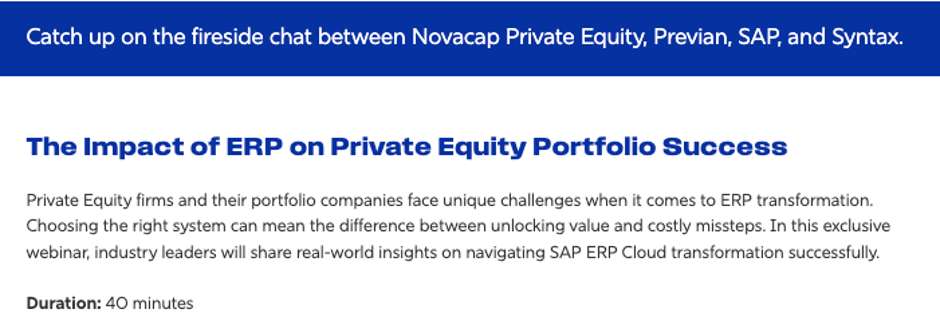In today’s fast-paced digital economy, cloud enterprise resource planning (ERP) systems are no longer just a back-office tool—they’re a strategic asset driving value creation, operational efficiency, and optimized exits within private equity (PE) portfolios.
Despite their well-documented benefits, many PE firms remain cautious about ERP modernization. Persistent misconceptions—such as the belief that cloud ERP implementations are slow, prohibitively expensive, and highly disruptive—still hold back decision-making in some corners of the industry. But the reality today tells a very different story.
For a deeper dive into the mechanics of ERP-driven transformation, explore our whitepaper.
Cloud ERP: From Bottleneck to Business Accelerator
Modern cloud ERP platforms have fundamentally reshaped the implementation playbook. Deployment cycles that once spanned years now take mere months. Upfront costs have been replaced by predictable, subscription-based pricing. Complexity has given way to simplicity, scalability, and rapid time-to-value.
In short, what was once considered a costly undertaking is now a powerful enabler.
ERP modernization is no longer a nice-to-have—it’s a strategic imperative.
For PE stakeholders focused on accelerating returns and maximizing exit value, cloud ERP is proving its worth by driving measurable outcomes across the investment lifecycle and optimizing total cost of ownership (TCO).
Total Cost of Ownership, Reimagined
Cloud ERPs are transforming TCO, emerging as the clear leader among ERPs in both financial efficiency and operational agility. By understanding the key evolutions reshaping ERP economics, PE firms can better position themselves for long-term success.
Here are five critical advancements that directly contribute to lower Total Cost of Ownership:
1. Flexible Subscription-Based Licensing
Unlike traditional on-premises ERP systems that demand hefty upfront infrastructure and licensing investments, cloud ERP platforms operate on predictable, subscription-based models that minimize initial costs. These plans typically include maintenance, upgrades, and infrastructure within their fees, reducing the burden on in-house IT teams and allowing organizations to redirect resources toward strategic innovation.
2. Shift from CapEx to OpEx
Cloud ERPs enable a transition from capital expenditure (CapEx) to operating expenditure (OpEx), improving liquidity and enabling more agile capital allocation. For PE firms, this financial flexibility not only supports growth but also positively impacts valuation multiples during exit by showcasing reduced IT costs and enhanced operational efficiency.
3. Proven Deployment Methodologies
Leading cloud ERP platforms, such as SAP Cloud ERP, use standardized, best-practice-based deployment models that reduce customization and accelerate time-to-value. This streamlined approach allows implementation in months—not years—leading to faster return on investment (ROI) and reduced risk.
4. Innovation-Driven Competitive Advantage
Modern cloud ERPs are inherently built to support innovation. With native capabilities in AI, machine learning, and predictive analytics, they enable real-time insights and smarter decision-making. These advanced features not only improve day-to-day operations but also provide a sustainable competitive edge across the portfolio.
5. Future-Proofing the ERP Ecosystem
By shifting the responsibility of upgrades, maintenance, and security to the vendor, cloud ERP systems mitigate future technical debt. This ensures continuous alignment with evolving technology standards while reducing long-term operational costs, making PE firms more agile and attractive to buyers.
The Operational Impact of ERP Transformation
To fully appreciate the value of cloud ERP, it’s essential to look beyond implementation and examine the broader operational and financial implications. When compared to traditional on-premises systems, cloud-based ERP solutions introduce a fundamentally different cost structure and operating model—one that delivers measurable advantages in TCO.
From licensing and maintenance to scalability and innovation, the differences are both substantial and strategic. The table below highlights some of the key contrasts:
Comparative Analysis:
Cloud vs. On-Premise ERP TCO
| Cost Component | Cloud ERP | On-Premise ERP |
|---|---|---|
| Initial Investment | Minimal upfront costs; subscription-based licensing | High upfront infrastructure spending; one-time license purchase |
| Maintenance & Support | Included in subscription; handled by provider | Requires in-house IT team; additional expenses for upgrades/patches |
| Operational Costs | Reduced IT complexity; economies on IT staffing; significant administrative savings | Higher ongoing costs for physical infrastructure, utilities, and dedicated IT personnel |
| Scalability & Flexibility | Unmatched scalability; adapts swiftly to market changes; flexible pricing | Not easily scalable; dependent on physical infrastructure; growth/updates are difficult and expensive |
| Security Management | Robust measures handled by provider; constant monitoring, updates, advanced recovery/backup | Total control, but requires significant internal budget and manpower for maintenance and upgrades |
| Disaster Recovery | Straightforward; managed by SaaS provider with backups and redundancies | Time-consuming and costly to develop and maintain; often requires additional hardware |
| IT Staffing Burden | Reduced need for internal IT for system maintenance; frees staff for strategic activities | High burden on internal IT for daily operations, troubleshooting, and upgrades |
| CapEx vs. OpEx | Shifts CapEx to OpEx; improves liquidity and agile capital deployment | Primarily CapEx; ties up significant capital in fixed assets |
Lay the Groundwork for ERP Modernization
As the PE landscape becomes more competitive and digitally driven, firms can no longer afford to treat ERP modernization as a back-office upgrade.
Cloud ERP is now a strategic lever—delivering not only operational efficiency and scalability, but also significant reductions in TCO.
The shift from rigid, capital-intensive infrastructure to agile, innovation-ready platforms positions portfolio companies for faster value realization and stronger exit outcomes.
For PE firms looking to accelerate transformation across their portfolios, investing in cloud ERP is no longer a question of if—but when.
To learn more about how your firms can capitalize on the TCO advantages of cloud ERP:
On-demand webinar: Avoiding Pitfalls in SAP ERP Cloud Transformation for Private Equity Portfolio Companies
Author

Amar Karande
Head of Private Equity at Syntax
Amar Karande is the Head of Private Equity at Syntax, where he leads the Global Private Equity business, partnering with strategic PE firms and portfolio leadership to drive technology-enabled value creation and risk mitigation across the investment lifecycle. With extensive expertise in ERP transformations, carve-outs, and cross-portfolio technology initiatives, Amar collaborates with Operating Partners, Deal Teams, and C-suite executives to implement innovative solutions, including AI-driven strategies and successful cloud initiatives.



